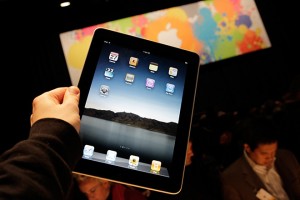The iPad is a great device. It’s light, ultra-portable, and you don’t have to take it out of your carry-on for airport security. It’s sleek and sexy. It’s remarkably versatile. Many people wonder: can I replace my Window laptop or MacBook with it? If I add a Bluetooth keyboard, is it a netbook?
You can try, but it’s like trying to get a Corvette to replace a pickup truck: they both serve the same fundamental purpose, but they each excel at different things. You can try to get your pickup up to 180 MPH, and you can try to haul a ton of bricks in your Corvette. With enough effort, “McGyver”-ing, and aftermarket accessories, you could no doubt accomplish each. But is it a good idea? And if you think it through ahead of time, do you really want to?
The longing to replace a laptop with an iPad is easy to understand. An iPad travels well. It’s simple to connect it to a Wi-Fi network, and you don’t have to wait for it to boot up. The battery lasts. When you’re not working, you can use it to play music, movies, or games. It’s a terrific reader for news and e-books. It’s a great email client for Gmail, AOL, and (if your company’s mail system supports it and the corporate policies allow it) Exchange mail, calendar, and contacts using ActiveSync.
But it’s important to remember that the iPad is NOT a laptop or a tablet PC. And, despite being an Apple product, it’s NOT a MacBook. It isn’t built on Windows or Mac OS X – its operating system (iOS) was originally developed for the iPhone. The interface uses multi-touch gestures and an accelerometer, making possible applications that can’t run on a PC or Mac. That also means that applications written for a PC or Mac can’t run on an iPad – unless the author specifically develops a version for iOS. Even then, they would need to publish their application through the Apple App Store (thus sharing their proceeds with Apple) – or you would need to jailbreak your iPad, voiding the warranty.
Importantly, the iPad (like the iPhone and iPod Touch) does NOT support Adobe Flash or Java, meaning that websites that use those technologies won’t behave as designed. Why not? Apple CEO Steve Jobs called the Adobe product insecure, buggy, battery-intensive, and incompatible with a touch interface.
The iPad is better at consuming information than it is at creating it. It’s great for creating and editing smaller emails and documents, but you’ll want a PC to create large or complex documents. Another challenge: once you’ve created or edited the smaller documents, you can email them from the iPad, but only one file per email. To send multiple files, you need to send multiple emails. This can be pretty cumbersome. You’ll note that as you explore the iPad you won’t even encounter the concept of a “file” as you would on a PC or Mac.
To think of the iPad as a replacement for a netbook, notebook, or MacBook is like thinking of the Corvette as a replacement for a Ford F350. Is it fair to call the iPad an overgrown iPhone? No. It’s a terrific multi-function device with some very valuable business purposes in specific situations. Should you expect it to behave like a Windows machine or Mac? You’ll only end up frustrated if you do.
Love the iPad for what it is, and don’t hate it for what it isn’t. And don’t expect your IT consulting company to help you make it do what it’s not designed to do – they can’t fit a ton of bricks in a Corvette, either.
So… what CAN the iPad do in a business network environment? In other words, what is reasonable to expect your company’s I.T. team to support?
- Email access. If your company allows remote email access from a smartphone using POP or IMAP protocols, you can do it from your iPad. Note, however, that it’s up to you go get the iPad connected to the Internet on the remote Wi-Fi. If you have a 3G iPad, getting it on the Internet is strictly between you, Apple, and AT&T.
- Calendar/Contact synchronization – if your company has a fairly new Exchange server and the network is configured to allow ActiveSync access. If you have a non-BlackBerry smartphone that wirelessly syncs Calendar/Contacts, your iPad can also.
- Remote Desktop to a Terminal Server – if your company has a Terminal Server. If you have access using Microsoft’s Remote Desktop Connection software for either Windows or Mac, you can have access from your iPad. Be sure to get a good RDP app such as iTap RDP, which makes it easier to operate a Windows desktop from with the iPad’s smaller display, and makes the best use of the iPad’s direct manipulation and multi-touch gestures.
- VPN access. If your company allows VPN connections from other devices, such as an IPSec VPN tunnel to a Cisco firewall or a PPTP connection to a Windows RAS Server, you can have the same connection from your iPad. You might use it to establish a Remote Desktop Connection to your office workstation, if your company’s policies allow this.
Now… what CAN’T you expect your company’s I.T. team to support? Pretty much anything not listed above. At its heart, the iPad is a consumer device, and is probably not included in the list of officially-sanctioned “clients” for your company’s server-based applications. There’s no doubt that the iPad will continue to evolve, and new apps are released every day that enhance its functionality and usefulness. But, as a mobile network device, it presents challenges in terms of data security, bandwidth usage, and compatibility. These translate into significant I.T. support costs, so don’t be too surprised if your company won’t support it.

